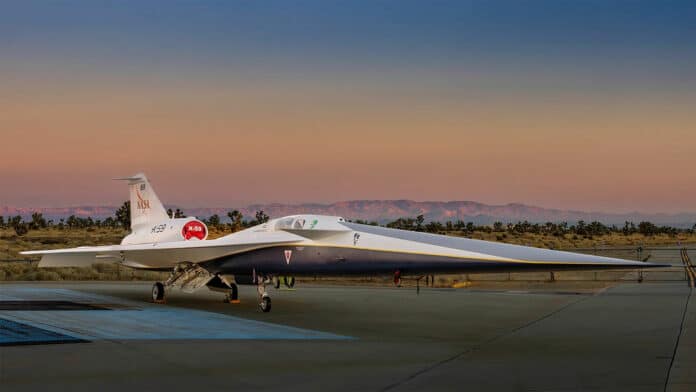NASA and Lockheed Martin have officially unveiled the X-59 quiet supersonic aircraft at the Skunk Works facility in Palmdale, California, after years of development. Using this one-of-a-kind experimental airplane, NASA aims to gather data that could revolutionize air travel, paving the way for a new generation of commercial aircraft that can travel faster than the speed of sound.
The X-59 is designed to break the sound barrier without causing the typical sonic boom. Instead, it will produce a much quieter “thump,” similar to the sound of a car door slamming as heard from indoors. The success of this jet has the potential to revolutionize supersonic flight and aviation in general.
In addition to revolutionizing air travel, NASA’s X-59 supersonic aircraft is also at the center of the agency’s Quesst mission. This mission aims to provide regulators with data that can help them reconsider rules prohibiting commercial supersonic flight over land.
For the past 50 years, such flights have been prohibited in the U.S. and other nations due to the disturbance caused by loud and startling sonic booms in the communities below. The X-59 is expected to fly at 1.4 times the speed of sound, or 925 mph while generating a quieter sonic thump, thanks to its unique design, shaping, and technologies.
With the rollout complete, the Quesst team will now move on to the next steps in preparation for the first flight. These steps include integrated systems testing, engine runs, and taxi testing for the X-59. The aircraft is scheduled to take off for the first time later this year, followed by its first quiet supersonic flight.
Several of the aircraft’s flight tests will be conducted at Skunk Works before it is transferred to NASA’s Armstrong Flight Research Center in Edwards, California, which will serve as its base of operations.
After completing flight tests, NASA plans to fly the X-59 over several cities in the U.S. to gather feedback on the sound it generates, as well as people’s perceptions of it. The goal is to provide this data to the Federal Aviation Administration and international regulators to inform future generations of quiet supersonic aircraft. It’s important to note that the X-59 is an experimental airplane, not a prototype, and its technologies will serve as a foundation for future projects.
The X-59 aircraft is 99.7 feet long and 29.5 feet wide. The aircraft is powered by a General Electric F414 engine with an afterburner generating 22,000 lb (9,979 kg) of thrust that will push the aircraft to a speed of Mach 1.5 at an altitude of 55,000 ft (16,800 m). This aircraft’s shape, along with its technological advancements, will make quiet supersonic flight possible. The X-59’s thin, tapered nose accounts for almost a third of its length, and it will break up the shock waves that would ordinarily result in a supersonic aircraft causing a sonic boom.
Due to this unique configuration, the cockpit of the aircraft is located almost halfway down its length and does not have a forward-facing window. Instead, the Quesst team developed a system called eXternal Vision System, which uses a series of high-resolution cameras that feed into a 4K monitor in the cockpit.
Additionally, the Quesst team mounted the engine of the aircraft on top and gave it a smooth underside to help keep shockwaves from merging behind the aircraft and causing a sonic boom.
“This is a major accomplishment made possible only through the hard work and ingenuity of NASA and the entire X-59 team,” said NASA Deputy Administrator Pam Melroy in the press release. “In just a few short years, we’ve gone from an ambitious concept to reality. NASA’s X-59 will help change the way we travel, bringing us closer together in much less time.”
